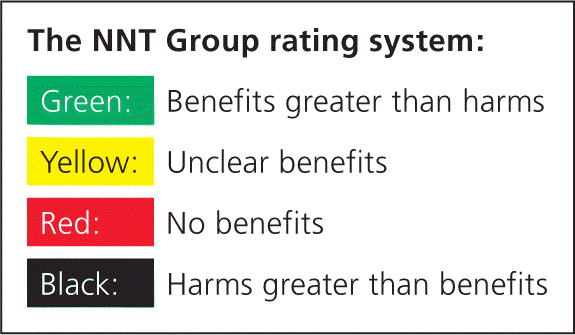
Am Fam Physician. 2016;94(1):online
Author disclosure: No relevant financial affiliations.


| Patients had improved pain control with topical NSAIDs compared with placebo without experiencing an increase in local or systemic adverse events. | |
|---|---|
| NNT = 2 for diclofenac gel, 3 for ketoprofen gel, and 4 for ibuprofen | |
| Benefits | Harms |
| 1 in 2 had improved pain control with diclofenac gel | No increase in local adverse events such as erythema or pruritus |
| 1 in 3 had improved pain control with ketoprofen gel | No increase in systemic adverse events such as headache, abdominal pain, or allergic reaction |
| 1 in 4 had improved pain control with ibuprofen gel | |
Details for This Review
Study Population: Patients 16 years and older with acute pain from strains, sprains, or sports/overuse type injuries
Efficacy End Points: Clinical success was defined variably as at least 50% pain intensity reduction, good or excellent response, or marked improvement or complete remission.
Harm End Points: Local skin reactions, systemic adverse events
Narrative: Musculoskeletal conditions and injuries affect a significant number of persons worldwide.1 Nonsteroidal anti-inflammatory drugs (NSAIDs) can effectively treat painful conditions, but have been associated with adverse cardiovascular, gastrointestinal, and renal effects.2 Topical formulations may provide adequate local pain relief without reaching systemic concentrations high enough to cause adverse events. This review evaluates topical NSAIDs for the treatment of acute (less than three months) musculoskeletal pain in patients 16 years and older.
This review included 61 studies involving 8,386 patients, of whom 5,311 were treated with a topical NSAID.3 Compared with placebo, topical NSAIDs were effective in providing pain relief for acute musculoskeletal conditions. Clinical success was reported by study participants and defined variably as at least 50% reduction in pain, a global assessment of treatment as good/excellent or improved/complete relief, or a rating of pain as absent/slight or a corresponding numerical value. Diclofenac gel, ketoprofen gel, diclofenac patches other than Flector, and ibuprofen gel seem to be the most successful, with numbers needed to treat (NNTs) of 2, 3, 3, and 4, respectively. Local skin reactions and systemic adverse events were rare and occurred similarly in the treatment and placebo groups.
Caveats: This review included a large amount of generally high-quality data; all studies were randomized, double-blind trials and were not considered to have a high risk of methodologic bias. However, the studies were not homogeneous in their treatment settings, patient types, or outcome definitions, and 27 studies had relatively small sample sizes, which may contribute to clinical heterogeneity and increased chance variation. The data were insufficient to make conclusions regarding comparisons of topical vs. oral NSAIDs, a specific topical NSAID vs. another, or different formulations of the same topical NSAID. Despite these limitations, topical NSAIDs do appear to provide adequate pain relief with minimal adverse effects, making them a viable treatment choice for patients 16 years and older with acute musculoskeletal pain.
This series is coordinated by Dean A. Seehusen, MD, MPH, AFP Contributing Editor, and Daniel Runde, MD, from the NNT Group (theNNT.com).
This review is available from the NNT Group at http://www.thennt.com/nnt/topical-nsaids-acute-musculoskeletal-pain-adults/.
